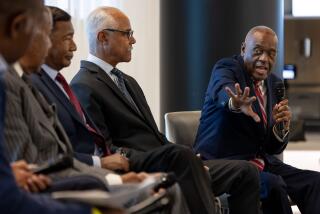New Hat; Some Scorn Included
- Share via
FT. BENNING, Ga. — Spc. Angela Pena spent two hours in front of the mirror shaping and adjusting her new black beret, saying she didn’t want to look like “a French baker.”
She and thousands of other U.S. soldiers, from the 38th Parallel in Korea to offices a world away from danger, replaced their baseball-style field caps and other headgear with black berets Thursday in a move intended to boost morale.
Pena will wear hers as a clerk here at the home of the Army’s elite Rangers, once the only U.S. soldiers who could wear black berets.
“I like it. I think it looks very professional,” said Pena, 22. “You just have to shape it to make sure it looks right.”
Army Chief of Staff Gen. Eric K. Shinseki ordered the change in October. Some Rangers grumbled, saying giving everyone the black berets cheapened something they had earned through their grueling training. In a compromise, they will be issued distinct tan berets next month.
Although active-duty soldiers refuse to criticize the change openly, some retired Rangers have opposed letting others wear what had been the exclusive headgear of the Rangers since 1974. The 2,000-person force takes on some of the military’s most hazardous missions.
“Putting the black beret on our soldiers’ heads to make them feel good is nothing more than putting a Band-Aid on a sucking chest wound,” said Emmett Hiltibrand, a Vietnam veteran and president of the 75th Ranger Regiment Assn. “We haven’t put much emphasis on training. We’ve put emphasis on feeling good and touchy feely.”
Only two other Army groups had been authorized to wear berets: Airborne (maroon) and Special Forces (green).
Shinseki has said the new berets will unify the force as it is reshaped for a world without a Cold War and a clear enemy. He said he developed the idea at a ceremony attended by smartly dressed Rangers last year at Ft. Bragg, N.C.
Capt. Melanie Sloan, who works in a blood bank at Ft. Bragg, said the new headgear would be appreciated by hospital workers.
“Us folks are here behind the scenes doing stuff for those soldiers,” she said. “They’re trying to make us all equal.”
Hours earlier in Seoul, South Korea, 700 soldiers standing in formation removed their camouflage hats and donned black berets in unison.
“The sun shines first on the tip of the spear, and 8th Army is proud to lead the Army this morning by donning a symbol of unity, commitment to excellence and agility: the black beret,” said Lt. Gen. Daniel R. Zanini, chief of staff of the 8th Army in Korea.
Each new beret is emblazoned with a blue patch representing the Continental Army, with 13 stars for the original Colonies.
Stephanie McWilliams, 17 and a recent enlistee, got her first look at the new berets during a ceremony Thursday at Atlanta’s Centennial Olympic Park.
“It’s tacky. What’s with the blue?” she said. “The green would probably match the uniforms better.”
Retired Ranger Robert Haywood wore his black beret to the Atlanta ceremony and criticized the Army. He said the Pentagon should have given everyone else the tan berets and allowed the Rangers to keep their symbol.
The beret replaces several other hats, but helmets and camouflage caps still will be worn during deployments, field training and in combat.
Only a third of the Army’s 336,000 soldiers had their berets in time for ceremonies Thursday. Production was delayed when members of Congress complained the Pentagon had used foreign manufacturers, including some in China.
More to Read
Sign up for Essential California
The most important California stories and recommendations in your inbox every morning.
You may occasionally receive promotional content from the Los Angeles Times.













